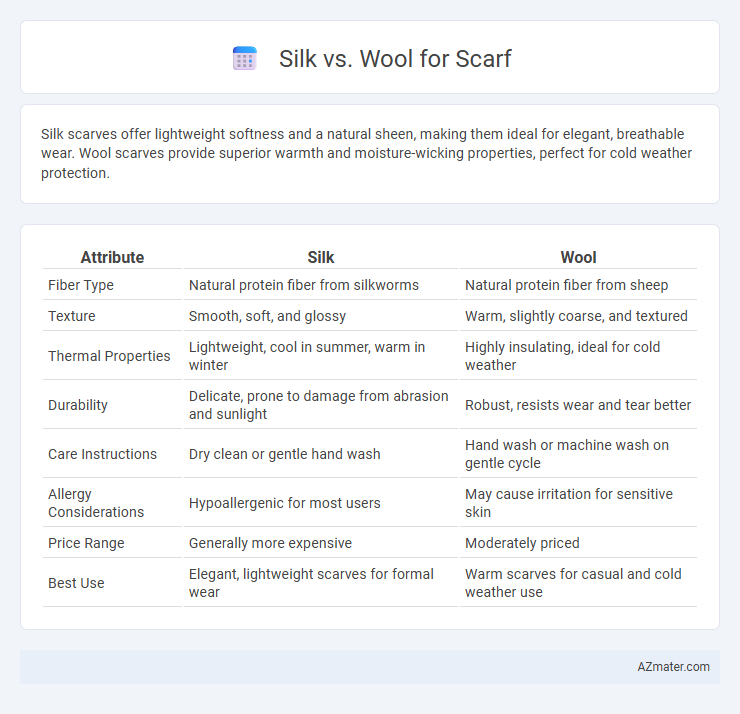Silk scarves offer lightweight softness and a natural sheen, making them ideal for elegant, breathable wear. Wool scarves provide superior warmth and moisture-wicking properties, perfect for cold weather protection.
Table of Comparison
| Attribute | Silk | Wool |
|---|---|---|
| Fiber Type | Natural protein fiber from silkworms | Natural protein fiber from sheep |
| Texture | Smooth, soft, and glossy | Warm, slightly coarse, and textured |
| Thermal Properties | Lightweight, cool in summer, warm in winter | Highly insulating, ideal for cold weather |
| Durability | Delicate, prone to damage from abrasion and sunlight | Robust, resists wear and tear better |
| Care Instructions | Dry clean or gentle hand wash | Hand wash or machine wash on gentle cycle |
| Allergy Considerations | Hypoallergenic for most users | May cause irritation for sensitive skin |
| Price Range | Generally more expensive | Moderately priced |
| Best Use | Elegant, lightweight scarves for formal wear | Warm scarves for casual and cold weather use |
Introduction to Silk and Wool Scarves
Silk scarves are prized for their smooth texture, natural sheen, and lightweight feel, making them ideal for elegant, breathable accessories. Wool scarves offer superior warmth and durability, crafted from natural fibers that provide excellent insulation against cold weather. Both materials combine functionality with style, catering to different needs and preferences in scarf selection.
Origins and Production Processes
Silk originates from the cocoons of the Bombyx mori silkworm, primarily cultivated in countries like China and India through a labor-intensive sericulture process involving careful harvesting and reeling of silk fibers. Wool is sourced from the fleece of sheep, with production concentrated in Australia, New Zealand, and parts of Europe, where sheep are sheared and wool is cleaned, carded, and spun into yarn. The production of silk involves delicate temperature control and preservation of filament length, whereas wool production emphasizes fiber crimp and lanolin removal to enhance texture and durability for scarf making.
Texture and Feel on the Skin
Silk scarves offer a smooth, luxurious texture that feels lightweight and cooling against the skin, making them ideal for sensitive or warm-weather use. Wool scarves provide a coarser but incredibly soft and insulating texture, perfect for retaining warmth in colder climates. The natural fibers in wool create a breathable yet cozy feel, while silk's hypoallergenic properties ensure comfort without irritation.
Warmth and Insulation Properties
Wool scarves provide superior warmth and insulation due to their natural crimped fibers, which trap heat effectively and wick moisture away from the skin. Silk scarves offer moderate insulation, excelling in lightweight warmth and breathability but lacking the thermal retention of wool. For cold climates, wool is preferred for its robust heat-trapping abilities, while silk suits mild conditions where temperature regulation is key.
Breathability and Moisture Management
Silk scarves offer excellent breathability due to their natural protein fibers, allowing air to circulate and keeping the skin cool. Wool excels in moisture management by efficiently wicking sweat away from the skin, maintaining dryness and warmth even in damp conditions. Both materials provide unique benefits: silk for lightweight comfort and breathability, wool for superior moisture absorption and insulation.
Aesthetic Appeal and Design Versatility
Silk scarves offer a lustrous sheen and vibrant color retention that enhances their aesthetic appeal, making them ideal for elegant and formal designs. Wool scarves provide a textured, cozy look with natural matte finishes, lending themselves well to casual and rustic styles. The design versatility of silk allows intricate patterns and delicate prints, while wool supports bulky knits and rich textures, catering to varied fashion preferences.
Durability and Longevity
Wool scarves offer superior durability and longevity due to their natural resilience, moisture-wicking properties, and resistance to wear and tear, making them ideal for frequent use in colder climates. Silk scarves, while luxurious and smooth, tend to be more delicate, prone to snagging and fading, requiring careful handling and less frequent use to maintain their appearance over time. Choosing wool ensures a longer-lasting investment in warmth and durability, whereas silk prioritizes elegance with a trade-off in lifespan.
Care and Maintenance Tips
Silk scarves require gentle hand washing with mild detergent and should be air-dried away from direct sunlight to maintain their smooth texture and vibrant colors. Wool scarves benefit from cold water washing with a specialized wool detergent, avoiding wringing or twisting to prevent fiber damage. Proper storage in a breathable container helps protect both silk and wool scarves from moths and moisture, extending their lifespan.
Eco-Friendliness and Sustainability
Silk and wool scarves differ significantly in eco-friendliness and sustainability, with wool being a renewable fiber sourced from sheep, often produced through more sustainable farming practices that support soil health and biodiversity. Silk production, while natural, involves energy-intensive processes and the harvesting of silkworms, raising concerns about animal ethics and higher water usage. Choosing organic or certified sustainable wool and silk can further reduce environmental impact by ensuring responsible land management and chemical use.
Choosing the Right Scarf: Silk or Wool?
Silk scarves provide lightweight softness and natural sheen, making them ideal for mild weather and elegant styles. Wool scarves offer superior warmth and insulation, perfect for cold climates and casual wear. Choosing between silk and wool depends on the desired warmth, texture, and occasion, with silk best for delicate comfort and wool for cozy protection.

Infographic: Silk vs Wool for Scarf
 azmater.com
azmater.com